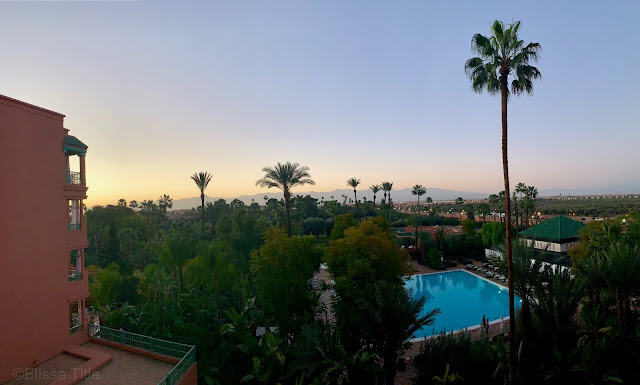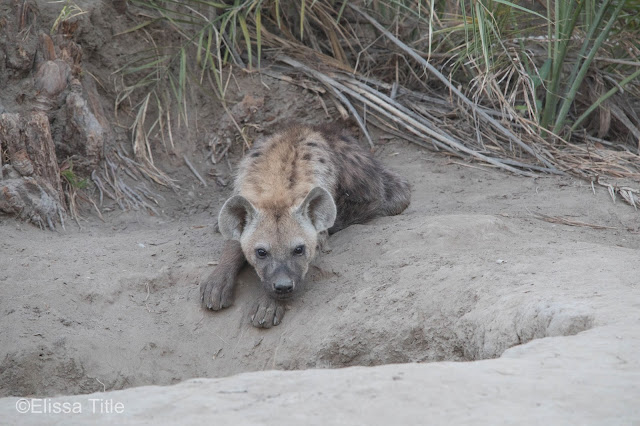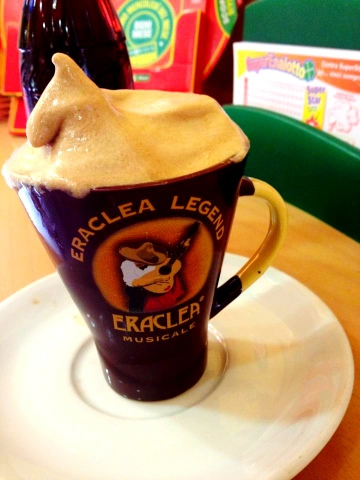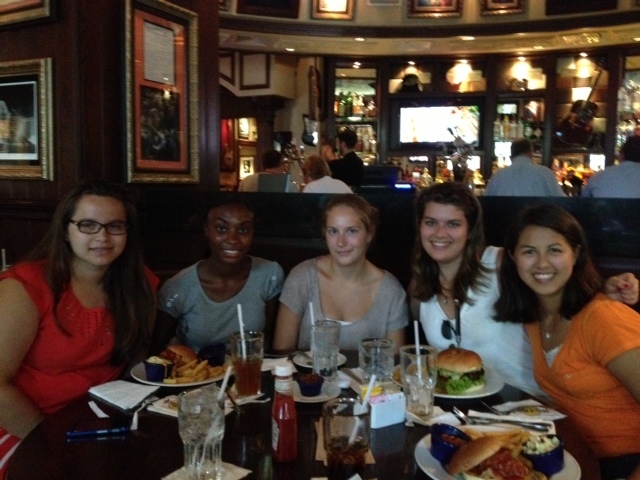 |
| Bread cooking in the oven. |
Locals in this neighborhood can make their own dough and bring it to this communal oven to be cooked.
 |
| The baker turns the bread over. |
In my mind, this oven is like a huge wood burning pizza oven that is extremely deep. In front of the massive oven, sheets are laid out for the already cooked and uncooked breads. We had the pleasure of tasting some bread right as it came out of the oven, and my goodness... I have never tasted bread so fresh!!
 |
| Bread lined up by the entrance to the oven. |
After our visit to the bakery, we went near the public bath where we met the man in charge of heating the furnace (called a Farnatchi). Dating back to the Roman's system of Hypocaust, the Farnatchi supplies the hammam with wood or sawdust. The hot air circulates and allows the heating of the rooms or basins of the thermal baths by the ground. The fireplace is located outside the baths and the entrance of the building with an opening to feed the fireplace. Another opening allows the smoke and the heat to be transmitted towards the hypocaust. The steam bath is made up of several rooms which get warmer and warmer depending on their distance from the fireplace. Besides heating the public baths, neighboring Riads (houses) bring pots of food to this oven so it can be placed in the embers of the Hammam oven. In Marrakech, the typical dish is Tanjia which cooks about 4 hours in an urn-shaped terracotta pot. The main ingredients of tanjia are meat (beef, lamb or chicken), garlic, saffron, cumin, salted lemon, tumeric, olive oil, and a dollop of smen (a salty type of butter).
 |
| The Farnatchi heating the water of the public baths. |
As we were photographing, the man came up to take a break and began playing the gimbri (also known as the sintir or hajhuj). It has three strings which are tuned with a tuning noose and can be raised or lowered to change the pitch. A metal piece with rings is attached to the neck of the gimbri, producing a jingling sound audible when it's played.
 |
| Playing the gimbri, a bass instrument. |
 |
| Decorations on the pack of the gimbri. |
 |
| Playing the gimbri as light shines through the building. |
We proceeded to walk around in the early morning, making our way to the artisans corner of the souk. We ended up stopping for some street food along the way!
 |
| En route to the souk. |
When we saw a huge line of people waiting near a food vendor, we asked what they were selling. The vendors were grilling fresh bread and stuffing the pieces with various fillings.
 |
| Grilling the bread. |
Msemen is a square crepe-like type of bread. Usually, it's served with sides of honey, butter and soft cheese. In this case, the bread was already spread with honey and soft cheese (usually the brand La Vache Qui Rit known in English as The Laughing Cow) and rolled up for an easy breakfast on the go. For the artisans in particular, quick street food is incredibly convenient with their long work hours.
 |
| Filling the bread with olive oil |
After the three fillings are inside the bread, it is rolled up...
And then it's time to eat it! This vendor was so crowded that they actually ran out of msemen. One lady from the shop came over to make one special for us... and on the house (one of the many examples of Moroccan hospitality).
 |
| This msemen made me wanting more! |
 |
| Mom, Andrea and I with our msemen |
After our foodie detour, we went to Herboriste La Sagesse, a traditional medicine shop in the souk. This herbalist shop has a wide range of products including herbs, spices for cooking, oils, and natural medications.
 |
| Outside of the shop |
 |
| Approaching the shop |
We went into a private room where we were offered Moroccan tea and shown samples of products. One of the biggest "must haves" in Morocco is argan oil, full of essential fatty acids, antioxidants, vitamins and minerals that promote your overall health by moisturizing, softening, and protecting your face from sun damage. Argan oil is produced from a nut of the Argan tree, which only grows in Southwestern Morocco. Another big hit is rose oil, also used to hydrate dry skin, clear acne, reduce signs of aging, minimize the appearance of scars, and more. In addition to the cosmetic benefits, rose oil is also meant to minimize stress, help you sleep better, reduce anxiety, and more. Another must have is Moroccan black soap that is used with a scrubbing kessa glove. After your skin is wet, you're meant to apply a thin layer of black soap, let sit for 5-15 minutes, rinse with water, and then exfoliate with the kessa glove. Black soap has a gooey consistency and is made from olives (typically 100% virgin black olive oil pureed with black olives) and a drop or two of essential oils. Morocco also has a range of smelling salts, used for sinus relief, that work wonders. All you have to do is add a few crystals to hot water and sniff it!
 |
| Drinking tea during the demonstration. |
Long story short, we came away from this amazing shop with lots of goodies (including fresh lemongrass tea leaves!!).
 |
| Spices, herbs, and oils lined the walls. |
We continued walking to the artisans section where we saw metal workers, leather workers, and more.
 |
| Walking in the artisan's part of the souk. |
Something that immediately caught my eye was a Moroccan pouf shop. These beautifully handmade ottomans come in all sorts of colors, but as we were strolling by I saw one with hues of blue, turquoise, and white. I immediately knew this would look fantastic in our new house in Dana Point and I knew we'd have to take it home!!
 |
| Moroccan pouf shop. |
 |
| Shopping in Morocco... Thanks for the pic, Andrea! |
 |
| Making friends at the pouf shop. |
After several hours (still not nearly long enough!!) of shopping, we headed to our next stop, Bahia Palace. En route, we passed the Koutoubia Mosque which is the 230 foot tall minaret of Marrakech's most famous monument. Visible for miles in all directions, this is a classic example of Moroccan-Andalucían architecture. Unfortunately, the inside isn't open to the public but the outside is stunning.
 |
| Minaret of the Koutoubia Mosque featuring the Moroccan flag. |
Several minutes later, we arrived at the Bahia Palace. From the outside, you wouldn't be able to guess how large this palace actually is.
 |
| Outside of the Bahia Palace. |
The palace of Bahia (palace of the beautiful) is a 19th century palace spanning eight hectares (nearly 20 acres). Between 1866 and 1867, this palace was built by Moroccan architect El Mekki in the southeast of the medina of Marrakech close to the current royal palace. This palace was built for Si Moussa, chamberlain of Sultan Hassan I of Morocco. The palace is made up of around 150 richly decorated pieces of moucharabieh (window enclosed with carved wood latticework located on the second story of a building or higher often lined with stained glass), marble carvings and paintings on beech and cedar wood, stucco, zellige, first stained glass windows of the Maghreb, and gardens planted with orange, banana, cypress, hibiscus and jasmine trees.
 |
| One of the outside gardens. |
Today, only a portion of the palace's eight hectares and 150 rooms is open to the public. As a graphic designer, this palace was heaven... the textures, the colors, the patterns were so intricate. Perhaps my favorite part of the palace was the zouak (painted wood) ceilings.
 |
| Painted cedar wood |
 |
| Beautifully painted ceiling on the entrance gate to a garden. |
 |
| Above ceiling in perspective |
 |
| Painted wood in one of the many rooms of the palace |
 |
| Orante ceiling in the palace |
I also fell in love with the mosaic floors...
And the combinations of colors and textures...
After a long day of sightseeing, we were exhausted. We went to the hotel, had a gorgeous buffet lunch by the pool, and began to repack for the long journey home. In the evening, we headed down probably one of the most Instagrammed hallways I've seen on the way to dinner.
 |
| One of the gorgeous hallways in the hotel. |
Moroccan cuisine is famous, with the chef Paul Bocuse once saying, "there are only three cuisines in the world: French, Chinese, and Moroccan". Morocco owes much of its distinct flavors to the ancient trade caravans which brought rare spices and other ingredients to the North African country. Berbers shared their traditions and foods like dates, lamb, honey and almonds while the French, Portuguese, Arab, and Spanish influencers made their way via caravans due to Marrakech's position as a gateway between Europe and Africa. Moroccan cuisine often uses fresh spices and produce and is influenced by Berber, Arabic and Mediterranean traditions. While lunch is the most popular meal, we had an endless supply of food for our farewell dinner.
 |
| Family style appetizers |
 |
| Range of meats, fish, and couscous for the main course |
 |
| Dessert table featuring local music |
 |
| Valentine's Day themed cakes |
After lots of music, belly dancing performances, and too much food, it was time to head to bed.
 |
| The outdoor hallway at night. |
On the morning of the 15th, we began our long journey home. I took one last look at the window...
We drove five minutes to the airport, boarded the plane for a final time (so we thought), and said farewell to Morocco.
We had a planned tech stop in the Azores, a small island owned by Portugal, where we ended up having to get off the plane, claim all our bags, go through security, re-check our bags and re-board the plane. Now exhausted from the 24 day journey, this was a long process but at least the views of the island were incredible!
After our three hour flight from Morocco to the Azores, about two hours on the ground in the Azores, almost 7 1/2 hours to Florida, almost two hours of waiting for our bags in Florida, and an hour transfer to the hotel, we were almost home (with only our 5 hour flight to Los Angeles remaining the following day).
 |
| Unpacking memories... Peruvian scarves, Tanzanian spoons, beaded placemats, koala salt shakers, Samoan coasters, Indian marble plates, Jordanian kufia's, Australian ice cubes, Cambodian tiger balm, Moroccan pouf, Moroccan black soap and essential oils, Tahitian pearls, and more |
This trip was full of ups and downs... From eating a ton of food in Peru, being evacuated from Easter Island and flown to Tahiti, relaxing in Samoa, getting a behind the scenes wildlife tour in Australia, being stuck on bedrest in Cambodia due to a nasty cold, wandering through bazars in India and drinking way too much masala chai, seeing Petra in the early morning with very few people, and shopping like a local in the medina in Morocco, it was definitely an eventful trip. To quote Anthony Bourdain, "Travel isn't always pretty. It isn't always comfortable. Sometimes it hurts, it even breaks your heart. But that's okay. The journey changes you; it should change you. It leaves marks on your memory, on your consciousness, on your heart, and on your body. You take something with you. Hopefully, you leave something good behind".
Thank you for reading about my latest adventures. My next trip is rapidly approaching... I'm leaving April 2 to go photograph tigers in India for two weeks! I'll be on a four person photographic safari where we will travel to Bandhavgarh, Pench and Kanha national parks in search of tigers, sloth bears, and so much more (in the heat and humidity)... Stay tuned for what’s to come and be sure to hit the subscribe button to be notified of new posts! As always, follow my Instagram @elissatitle for more pics.














































.jpg)






Beautiful!
ReplyDeleteThank you!! Loved Morocco!
Delete